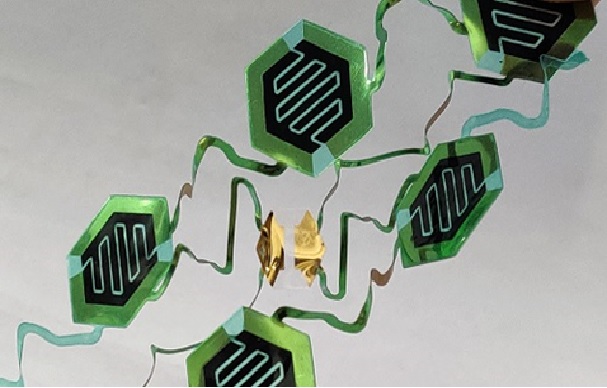New Technique Developed to Devise Wearable Sensors
The method enables prototyping and testing of new designs much faster while reducing developing costs by great extent.
Wearable sensors ranging from adhesive skin bandages to stretchable implants on organs monitor health or diagnose illnesses and are of huge help for gathering medical data from patients over extended time periods.
Photolithography, is a standard, multistep process that uses light to create patterns on semiconductors for fabricating PCBs and microprocessors. Often done in clean rooms to avoid even a speck of dust ruining the fabrication, the process is quite expensive, which also involves a US$200 vinyl cutter. [1]

Figure 1. New Technique Developed to Devise Wearable Sensors
Figure 1 shows Wearable sensors are often used by researchers to gather medical data from patients over extended periods of time. They range from adhesive bandages on skin to stretchable implants on organs, and harness sophisticated sensors to monitor health or diagnose illnesses. These devices consist of flat wires, called interconnects, as well as sensors, power sources and antennas to communicate data to smartphone apps or other receivers. To maintain full functionality, they must stretch, flex and twist with the skin and organs they are mounted on — without generating strains that would compromise their circuitry. To achieve low-strain flexibility, engineers use an "island-bridge" structure, Xu said. The islands house rigid electronics and sensor components, such as commercial resistors, capacitors and lab-synthesized components like carbon nanotubes. The bridges link the islands to one another. Their spiral and zigzag shapes stretch like springs to accommodate large deformations. [2]
Moreover, the materials and processing technologies involved have also been discussed in recent years, along with their monitoring schemes and system-level integration technologies. Finally, the probability of wearable sensors being used in early disease detection is considerable. Thus, despite potential challenges, it is still quite promising for wearable sensors to come into production. [3]
References:
- https://www.electronicsforu.com/special/editor-choice/new-technique-wearable-sensors
- https://www.printedelectronicsworld.com/articles/25936/a-new-technique-for-making-wearable-sensors
- https://www.sciencedirect.com/science/article/pii/S2666138121000165
Cite this article:
Thanusri swetha J (2022), New Technique Developed to Devise Wearable Sensors, Anatechmaz, pp. 193

